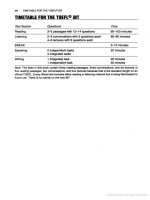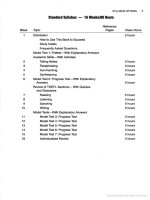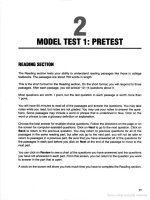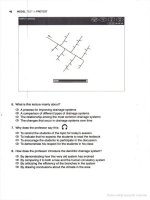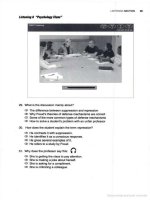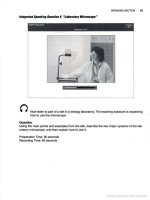Toefl ibt internet based test 2006 - 2007 part 83 potx
Bạn đang xem bản rút gọn của tài liệu. Xem và tải ngay bản đầy đủ của tài liệu tại đây (731.89 KB, 7 trang )
664
ANSWERS AND AUDIO SCRIPTS
FOl=I
ACnvmES,
OUIZZES,
ANO
MODEL TESTS
Studenl 1: Yeah. It sure would.
ProteSSO/"
:
Now,
lei's talk
about
why most
01
us
probably aren' reading
at
that
speed
.•.
at
1000
WOfds
a minute . . .
why
we·re
not doing that
now.
We know thet
we
have the capacity-that our brains
can
take II
In.
there are a
tew
1
~
they
seem
to
be
speaking while they'
re
reading. This
is
a serious
problem because
we
can
only speak aboul
300
words per minute, bul,
uh,
our capacity
10
read
It's
ma
ny limes
ll15ter
. So il
you
'
re
hearing
the
words In your head
or
moving your lips,
you
know that
you
'
re
preventing your mind lrom processing as 1
115
1115
it
can.
Can
any
01
you
relale
10
thaI?
Student
2: I can. I hear every
woo::I.
Professor:
A
101
01 people do. Now, another problem
IS
something called flX8tions. ·
Fb.!.
__ Jliuiiijil
p"
L '
~
~We
can' see while
the
eye
Is
moving
so
we
haw
to
slop
10
lake In the text. Every·
one
has to fixale
to
see the print,
bu
t,
uh,
some
people
they stop their eyes
on
every
Single
word and
that
witl
really slow you down.
So
11
you·re Iooklng at every word or even at every lew words, that habit
is something
to
wor1I
on
.
When
you're
not
readlng word
by
word, your mind has
10
connect and. uh,
build associations and
and patterns.
You
can
do this because
$0
much
01
a wrillen text
Is
redun-
danl-thal
means that there's a lot of repelltion, so quite a lew words can
be
skipped without losing the
mean
i
ng
.
Studenl3:
So
you're saying
we
should Iry
to
guess lhe meaning?
Prolessor:
I think I would use the lerm predlctralher than guess, but basically the answer 10 your question
Is
"'yes."
Now
thi
s
may
surprise
you
.
Us
i
ng
a dictionary is a goodhabit. Righi? Well,
yes,
in
moderation. But slop-
ping to look up eve/)' new word
Is
a
bad
habit because
you
don' need 10 know every word
In
order
to
undersland
wh
at
you
'
re
read
ing.
Remember whal I lust said aboul redundancy. So, uh, stopping to use
the dictionary 100 oIIen
•
thallntemJpIs your Iraln
01
thoughl
and
,
uh,
prevents
you
from reaching your
potantiat read
ing
speed
.
sludent3:
I've heard that
be/Of"e
and II makes seose
but
.•.
Professor:
But you're alraid
to
try it?
Student
3: That's probably true.
Professor:
~
11
CII)In.
I3iCIi:
fiitlii"iftiliiili: Fnt T
Iii
*1iiiI
Orii
mort
iiI:jiijI
A
lo
t
01
readefS
go
~
back over the words they've already read
10
clarity the
mean
ing.
Bulthis
Is
probably
the
worst habit
because,
uh,
when
we
'
re
repealing twice
or
even more times, that causes our reading
speed
10 drop
and
II
goes to.50
or
even
30 percenl
01
our capacity.
Did
I mention that "
tillidi9
""iF Okay,
~
well
th
is
regression not only slows us down, it also makes II more diffiCult to understand the meaning
because,
uh,
the way thaI
we
comprehend
•
we understand
by
coonecting with the nexl phrase.
so
all
the time makes
us
lose the connection
s.
I
c:ompreheosJon
01
you
do::~:"~'~
A~rn:t
~:::~
thai
ar
e causing
you
to
read
slowly.
Don' think the words in your
head
01"
move
your
Ups
to
sound
out
)pynqht'Jd mil n 11
664
ANSWERS AND AUDIO SCRIPTS
FOl=I
ACnvmES,
OUIZZES,
ANO
MODEL TESTS
Studenl 1: Yeah. It sure would.
ProteSSO/"
:
Now,
lei's talk
about
why most
01
us
probably aren' reading
at
that
speed
.•.
at
1000
WOfds
a minute . . .
why
we·re
not doing that
now.
We know thet
we
have the capacity-that our brains
can
take II
In.
there are a
tew
1
~
they
seem
to
be
speaking while they'
re
reading. This
is
a serious
problem because
we
can
only speak aboul
300
words per minute, bul,
uh,
our capacity
10
read
It's
ma
ny limes
ll15ter
. So il
you
'
re
hearing
the
words In your head
or
moving your lips,
you
know that
you
'
re
preventing your mind lrom processing as 1
115
1115
it
can.
Can
any
01
you
relale
10
thaI?
Student
2: I can. I hear every
woo::I.
Professor:
A
101
01 people do. Now, another problem
IS
something called flX8tions. ·
Fb.!.
__ Jliuiiijil
p"
L '
~
~We
can' see while
the
eye
Is
moving
so
we
haw
to
slop
10
lake In the text. Every·
one
has to fixale
to
see the print,
bu
t,
uh,
some
people
they stop their eyes
on
every
Single
word and
that
witl
really slow you down.
So
11
you·re Iooklng at every word or even at every lew words, that habit
is something
to
wor1I
on
.
When
you're
not
readlng word
by
word, your mind has
10
connect and. uh,
build associations and
and patterns.
You
can
do this because
$0
much
01
a wrillen text
Is
redun-
danl-thal
means that there's a lot of repelltion, so quite a lew words can
be
skipped without losing the
mean
i
ng
.
Studenl3:
So
you're saying
we
should Iry
to
guess lhe meaning?
Prolessor:
I think I would use the lerm predlctralher than guess, but basically the answer 10 your question
Is
"'yes."
Now
thi
s
may
surprise
you
.
Us
i
ng
a dictionary is a goodhabit. Righi? Well,
yes,
in
moderation. But slop-
ping to look up eve/)' new word
Is
a
bad
habit because
you
don' need 10 know every word
In
order
to
undersland
wh
at
you
'
re
read
ing.
Remember whal I lust said aboul redundancy. So, uh, stopping to use
the dictionary 100 oIIen
•
thallntemJpIs your Iraln
01
thoughl
and
,
uh,
prevents
you
from reaching your
potantiat read
ing
speed
.
sludent3:
I've heard that
be/Of"e
and II makes seose
but
.•.
Professor:
But you're alraid
to
try it?
Student
3: That's probably true.
Professor:
~
11
CII)In.
I3iCIi:
fiitlii"iftiliiili: Fnt T
Iii
*1iiiI
Orii
mort
iiI:jiijI
A
lo
t
01
readefS
go
~
back over the words they've already read
10
clarity the
mean
ing.
Bulthis
Is
probably
the
worst habit
because,
uh,
when
we
'
re
repealing twice
or
even more times, that causes our reading
speed
10 drop
and
II
goes to.50
or
even
30 percenl
01
our capacity.
Did
I mention that "
tillidi9
""iF Okay,
~
well
th
is
regression not only slows us down, it also makes II more diffiCult to understand the meaning
because,
uh,
the way thaI
we
comprehend
•
we understand
by
coonecting with the nexl phrase.
so
all
the time makes
us
lose the connection
s.
I
c:ompreheosJon
01
you
do::~:"~'~
A~rn:t
~:::~
thai
ar
e causing
you
to
read
slowly.
Don' think the words in your
head
01"
move
your
Ups
to
sound
out
)pynqht'Jd mil n 11
EXPLANATORV OR EXAMPLE ANSWERS AND AUDIO SCRIPTS
FOR
MODEL TES
TSiIoAOO
EL T
ES
T 4 665
each word.
Don'
let your eyes pause
on
every
word
.
Don'
look
up every
new
word
in the dictionary.
And
IIy
not
to
go back oyer paragraphs
and
, uh, sentences that you've already read. But, that's hard to
do
it you have these habits.
Is
n~
it? Especially
~
you're also II'ying to read
In
order to learn a
new
sub-
ject. That's why you're afraid to try it
because, uh, you have to learn the content In order to pass the
course
and
you
don'
want to try something
new
•
to take a
riSk
.
Student
3; Yeah. That'S abOut the size
0111.
"",;;;e;;d
atlwlce
the
speed
you're reading
Au
dio
29. What
Is
this discussion mainly about?
An
swe
r B How
tQ
read faster
A
ud
io
30
.
An
.wer
A
Au
dio
31
.
An
swe
r 8
Aud
io
32
.
Re
pl
ay
A
udi
o
Re
pl
ay
An
swe
r
C
How
does the professor Q
rg
an
ile
the discussion?
She
cites research to support
her
arguments. She
does
this at seVefai points In the
discussion.
Why
does the professor mentiOn running?
To make a comparison between reading and running
Listen
again to part
of
the discussioo and then answer the following
question
.
"Wen.
"1
come
bacK
tQ
that In a minute. First I
want
te
point out ooe
more
problem."
Why
does the professor say this:
"Well,
111
come
baCk
to
that in a minute."
She thinks
the
kIoa will lit In
buller
laler
011.
Prole$$Ofs
1.I1ten
make a comment and !hun
remark that they will "
come
back" or "get back"
tQ
it
later. This
Is
usually an
IncIication
that the Information retales
to
poInlS thai will
be
made tater In the lecture.
Aud
io
33
. The professor mentions several negative habits. Match these habits to the explana-
tloos.
Click 00 the habit and drag II to the correct explanatioo.
An
swe
r
Habit Expianalioo
A Fixating Pauses
Ihal
the
eye
makes
C Regressing Reading the
same
words more than once
B
Aud
itOl)' readi
ng
MQving yI.Iur lip$ while reading
Aud
io
34
.
An
swe
r D
What
would
the
pro
fessor
~y
like the students to do?
Gel
help at the Learning Center
)pynght mater I
EXPLANATORV OR EXAMPLE ANSWERS AND AUDIO SCRIPTS
FOR
MODEL TES
TSiIoAOO
EL T
ES
T 4 665
each word.
Don'
let your eyes pause
on
every
word
.
Don'
look
up every
new
word
in the dictionary.
And
IIy
not
to
go back oyer paragraphs
and
, uh, sentences that you've already read. But, that's hard to
do
it you have these habits.
Is
n~
it? Especially
~
you're also II'ying to read
In
order to learn a
new
sub-
ject. That's why you're afraid to try it
because, uh, you have to learn the content In order to pass the
course
and
you
don'
want to try something
new
•
to take a
riSk
.
Student
3; Yeah. That'S abOut the size
0111.
"",;;;e;;d
atlwlce
the
speed
you're reading
Au
dio
29. What
Is
this discussion mainly about?
An
swe
r B How
tQ
read faster
A
ud
io
30
.
An
.wer
A
Au
dio
31
.
An
swe
r 8
Aud
io
32
.
Re
pl
ay
A
udi
o
Re
pl
ay
An
swe
r
C
How
does the professor Q
rg
an
ile
the discussion?
She
cites research to support
her
arguments. She
does
this at seVefai points In the
discussion.
Why
does the professor mentiOn running?
To make a comparison between reading and running
Listen
again to part
of
the discussioo and then answer the following
question
.
"Wen.
"1
come
bacK
tQ
that In a minute. First I
want
te
point out ooe
more
problem."
Why
does the professor say this:
"Well,
111
come
baCk
to
that in a minute."
She thinks
the
kIoa will lit In
buller
laler
011.
Prole$$Ofs
1.I1ten
make a comment and !hun
remark that they will "
come
back" or "get back"
tQ
it
later. This
Is
usually an
IncIication
that the Information retales
to
poInlS thai will
be
made tater In the lecture.
Aud
io
33
. The professor mentions several negative habits. Match these habits to the explana-
tloos.
Click 00 the habit and drag II to the correct explanatioo.
An
swe
r
Habit Expianalioo
A Fixating Pauses
Ihal
the
eye
makes
C Regressing Reading the
same
words more than once
B
Aud
itOl)' readi
ng
MQving yI.Iur lip$ while reading
Aud
io
34
.
An
swe
r D
What
would
the
pro
fessor
~y
like the students to do?
Gel
help at the Learning Center
)pynght mater I
EXPL.ANATORY OR EXAMPLE ANSWERS AND AUDIO SCRIPTS FOR MODEL
TESTSIMOOEl
TEST"
669
Advisor:
StlJdent:
Advisor:
Well, I think you nave
a couple
01
options. You can
tell
ner
thai
you
can'
let
het
use
your
cen
phone anymore,
and
you can o
ll
et
10
90
with
her
10
buy
her
own
ceU
phone
.
That
way
shell
see that you're
trying
to
nelp.
That
might
work
, but
she1
probably still
be
upset
•
Or
another possibility
Is
.•.
you
could
lei
her
use your cell
phone
if she pays you
lor
the
extra minutes thaI you have had
10
COVet
f
or
her
, and II
she
agrees to pay
her
snare
of
all
the
bills from
now
00.
JUS!
tell
her
that you
can'
allotd
it.
Narrator t : Describe
the
woman
's problem
and
the
two
suggestions that
her
aclvisor makes
aboul
hoW
to
nandle
it
What
do
you
think
the
woman should do, and wtly7
Narrator
2:
Please
prepare your answer alter the beep.
[Preparation time: 20 seconds]
Na
rrator 2:
Please
begin
speakhg
after the
beep
.
[Recording
lime
: 60 seconds]
hlltWrlD
SrfM.a
Owl"
6
"l/MAJI
WUlEE"
Narrator 2: Nu
mber
6.
Uslen
to
part
of
a lecture. Then listen for a question about it. After you hear
the
question, you have 20 seconds to prepare,
and
60
seconds
to
record
your
answer.
Narrator 1:
Now
listen
to
part
01
a lecture In a biology
class
. The professor
is
diSC1Jssing
the types
01
habitats
lor
wildlife lound In dIIes.
Professor:
AHhough cities have
not generally been assoelated
with
wildlifa, there are many
spocies
that have
become
so
much • part
01
the
urtlan landscape that !hey Qle,
lor
the most pan, unnoticed neighbors.
For example, In
New
York's Central
Par1<
, almost 300
species
01
birds have been identified. Urban parks
certafiy provide
some
01
the worIcI's safesl
and
In
many
ways,
besl
wildlife nabitats, and
as
the
natural
nabita
ls
shrink.
weN
, these urtlan parks will
become
more
and
more
important to
the
conservation
of
wiltlife
, including
not
only birds
•
but, uh
but also freshwater animals and,
even
small
mammals.
So.
as
you see, man-made areas are
one
important type
01
habitat in Cities.
But
artificial structures
in
the
urban landscape
•••
these
can
also
provide
a home
lor
animals
that
adapt 10 life In the city.
For
Instance, chimney swifts are birds that
origlnaly
wed in
hollow
trees
,
but
now
ch
imney swifts are
c0m-
monty found In
!he
long brick chimneys In lactories or other vertical
shafts
In tall buildings. Think about
it. A city
has
more
chimneys !han lhere are
I'IoIIow
trees in a lorest
01
equal area. Consequently, these
birds IIock
10
the city. Another case of adaptation Is
the
urban drainage sys
le
m, which is usually made
up
of
concrete ditches, and they naturally attract stream
and
marsh animals. Again,
to
use
New
York
City
as an example. probably
250
species 0I1ish are found
~
the
harbor.
many
of
which
make their way
Into
the
pools
and
ponds
and
citc:hes In
!he
New
York drainage system. In Boston,
the
Back Bay was
actually designed to create nabitals
and
attract marshland wildlife to
!he
city.
righted
a1er
610 ANSWERS
AND
AUOIO SCRIPTS FOR ACTIVITIES, QUIZZES,
ANO
MOOEL TESTS
Narrator t : Using the main points
and
e)(ampies
from
the lecture,
desaibe
the
two
general types of
habitats
for
wildlifa found
In
urban areas.
Narrator
2: Please prepare your
answer
aftef the beep .
[Preparation time:
20
secoods]
Narrator 2: Please begin speaking after the beep .
",
[Recording lime:
60
seconds]
~
Writing
IwrHllArED
&sAr
"JET
SnIEAMs"
FlrSI,
read the passage on pages 361 362
and
take notes.
()
ModeIT"'14.
'
Wrltin9Sec11~.C07,
TntCk2
Narrator:
Now
listen
to
a lecture
on
the
same topic as the paasage that you have just
read.
Professor:
In North America, the jet stream usually separates cold
ai
r from the polar region
In
the north from
warmer
air
to
the
south, so iI'S called the polar jet stream. Okay, when
Ifs
cold In the Un
ited
States, the
polar
jet stream often dips south Into
Te)(as
or even
as
far as
Me)(ico
, and when
ifs
hot, the jet stream
retreats
Into Canada.
Now,
think about some of the trips
you
may have taken across counlly.
Did
you
notice that
the
airilne schedules factor
in
tile efteet
of
the jet
st
r
eam
on
night limes? For
e)(ample:,
if
you
were
IlyIng
from
Los
Angeles
to
New
York,
the flight
would
be
more
than
0119
hoor shorter
than
your
retum trip
from
New
Yo
rk
to
Los Angeles.
Why
would this
be
so,
do
you
th
ink? Well, because a particu-
larty
strong jel stream
can
PfOvide
a strong tailwind that moves the plane along faster as it lravels with
the
w
ind,
but on the way back, the plane will encounler a headwind,
and
~
wil
l have to travel against lhe
wind.
So the flight
will
lake longer. And the plane will
atso
consume more l
uel
when it's traveling against
lhe jet slream,
and
you" probably
also
feet
more turbulence.
Besides
thaI.
the
weather for your flight
can
also be affected by the jet stream because
th
is
strong currenl
of
air
moves
weather systems
and
storms around the world
by
pushing them forward, jusllike the tailwind thaI pushes your plane.
)pynghlOO
maier
EXPlANATORY OR EXAMPlE
ANSWERS
AND
AUDIO
SCRIPTS
FOR
MOOEL
TESTS
/
MODEL
TEST
of
611
•
EIample
Answers
and
Checklists
'or
Spooking
and
Writing
o
Model
Test
4, Example
Answe
rs.,
CO 1, Track 3
EwTtl
AIno
RIR
bwn
.,,
SPEu.I
OuunDlf
1
"A
em"
111
could
viSiI
any
City
in
!he
WOOd
, I'd like
to
see
Rome
because
I'm
an
architecture
majOr
,
and
II
would
be
exciting
to
see the structures
in
the old city li
ke
the
Cdossoom
and the Forum and, uh, temples. I'd
also
wanl
to
I
nspect
the aIches that define the perlmetet
01
the
old
city
. I
th
i
nk
one
01 them Is
almost
2000
years old, but it's stin supposed to
be
quite
beautiful and strong.
In
e
book
about
Rome. I read thai
!he
streels In the old
city
are made
of
the
originaJ
cobblestones laid
in
ancient times. So
besides
seeing
the architecture. it would
be
eliciting
10
walk
on
,he
stones. I
have
a good imagination, and I'm
sure
I
could visualize soldiers and philosophers even ill'm looking at a lot
01
othef
tourists.
'"
The talk
answers
the topic question.
'"
The
point
of
view
or
position is clear.
'"
The talk is direct
and
well
«ganized
.
'"
The
senTences
are
logically connected.
'"
Details
and
8l!8mples
suppof1
the
ma
in
Idea
.
'"
The speaker
expresses
compIele
thoughts
.
'"
The meaning is easy 10 comprehend.
'"
A wide range
of
vocabulary is used.
'"
There
are
only
miOOf
IIffOfS
in
grammar
.
'"
The talk is within a range
01
t
25-
150
WOtds
.
E.wIrrE
_,.
hl
__
fllTl
SI'fu.;
QuonDlf
2 "
SaIoDt.s
"
I
think
a
coeducational
school is a better environment
lor
both
men
and
women
because
II's
more
rep-
res&ntative
of
The
the,
uh
, wortcIthat
they'llive
in after \hey finish school. In
modem
society.
men
and
W'OfTIen
wi
ll
compete
lor
employment opportunities
so
ii
's
good
pracIioe
TO
compete
in
classes. And
men
and
women
need
to
leam
how
to
intllf8Ct
.socially
, and a coeducational
school
prov\des
actMties
and
soeIaJ
events
where
they
can
assodale
with
each
other
in
a
somewhat
supervised
en
vi
ronment.
So
t think II
men
and
women
are
separated throughout their
schooIlile
, iI
mlghl
be
I'Iarder
lor
them to
wont
together
and
develop
social
relationships after they fini
sh
school.
Clllctiist 2
'"
The talk
answers
the Iopic question.
'"
The point
01
view
or
position
II
clear
.
'"
The
talk.
Is
direct and well-orgsNzed.
'"
The
senlenoes
are
logically
connected.
'"
Details and examples support the
maln
Idea
'"
The speaker
expresses
comple
te thoughts.
'"
The meaning is
easy
to
comprehend.
'"
A wide range
01
YOCabulary
Is
used
.
'"
There
are
only
minor errors in
grammar
.
'"
The
tallIls
within a range
01125-150
words.
nghled ater

